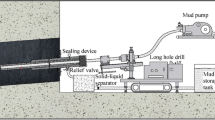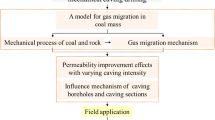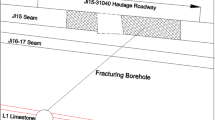Abstract
Coal mine researchers have been studying the subject of improving the effect of gas drainage to control gas accident. This paper focuses on a new permeability-improvement technology, liquid carbon dioxide phase change fracturing technology. This technology can be classified as physical blasting by using the phase energy of liquid carbon dioxide in the drilling underground coal mine. According to the results of field tests, by applying the liquid carbon dioxide phase change fracturing technology, the radius of the damaged area in the coal body around the drilling reached 5 m. Also, compared with the original coal body, the permeability of the damaged area increased approximately six times. In addition, based on the permeability of the damaged area, the influence of the liquid carbon dioxide phase change fracturing technology on the gas drainage radius was analyzed by numerical calculation. It can be observed from the numerical results that the effect of gas drainage was improved greatly by the liquid carbon dioxide phase change fracturing operation. Research results of this paper can contribute to safe and efficient mining of coal mines.










Similar content being viewed by others
References
Anon (1995) Cardox system brings benefits in the mining of large coal. Coal International 243(1):27–28
Barati R, Hutchins RD, Friedel T, Ayoub JA, Dessinges M, England KW (2009) Fracture impact of yield stress and fracture-face damage on production with a three-phase 2d model. SPE Prod Oper 24(2):336–345
Barati R, Liang JL (2014) A review of fracturing fluid systems used for hydraulic fracturing of oil and gas wells. J Appl Polym Sci 131(16)
Burton TG, Rifai HS, Hildenbrand ZL, Carlton DD, Fontenot BE, Schug KA (2016) Elucidating hydraulic fracturing impacts on ground water quality using a regional geospatial statistical modeling approach. Sci Total Environ 545:114–126
Cai F, Liu Z (2011) Intensified extracting gas and rapidly diminishing outburst risk using deep-hole presplitting blast technology before opening coal seam in shaft influenced by fault. Procedia Eng 26:449–456
Cheng YP, Wang L, Zhang XL (2011) Environmental impact of coal mine methane emissions and responding strategies in China. Int J Greenh Gas Control 5:157–166
Chen HD, Cheng YP, Zhou HX, Li W (2013) Damage and permeability development in coal during unloading. Rock Mech Rock Eng 46:1377–1390
Chen HD, Cheng YP, Ren T, Zhou HX, Liu QQ (2014) Permeability distribution characteristics of protected coal seams during unloading of the coal body. Int J Rock Mech Mining Sci 71:105–116
Gregory K, Mohan AM (2015) Current perspective on produced water management challenges during hydraulic fracturing for oil and gas recovery. Environ Chem 12(3):261–266
Guo D, Pei H, Song J, Qin F, Liu X (2008) Study on splitting mechanism of coalbed deep-hole cumulative blasting to improve permeability. J China Coal Soc 33:1381–1385
King GE (2012) Hydraulic fracturing 101: what every representative, environmentalist, regulator, reporter, investor, university researcher, neighbor and engineer should know about estimating frac risk and improving Frac performance in unconventional gas and oil wells. SPE Hydraulic Fracturing Technology Conference. Society of Petroleum Engineers, The Woodlands, Texas. February, In, pp 6–8
Li Q, Lin B, Zhai C (2014) The effect of pulse frequency on the fracture extension during hydraulic fracturing. J Nat Gas Sci Eng 21:296–303
Liu J, Liu Z, Gao K, Ma X, Li Z, Guo L (2014) Experimental study and application of directional focused energy blasting in deep boreholes. Chin J Rock Mech Eng 33:2490–2496
Long SC (2014) Direct and indirect challenges for water quality from the hydraulic fracturing industry. J Am Water Works Assoc 106(11):53–57
National Coal Mine Safety Supervision Bureau (2009) Provisions of the prevention of coal and gas outburst, Beijing
Rogers JD, Burke TL, Osborn SG, Ryan JN (2015) A framework for identifying organic compounds of concern in hydraulic fracturing fluids based on their mobility and persistence in groundwater. Environ Sci Technol Lett 2(6):158–164
Rutqvist J, Tsang CF (2002) A study of caprock hydro-mechanical changes associated with CO2-injection into a brine formation. Environ Geol 42:296–305
Singh SP (1998) Non-explosive applications of the PCF concept for underground excavation. Tunneling and Underground Space Technology 13:305–311
Stringfellow WT, Domen JK, Camarillo MK, Sandelin WL, Borglin S (2014) Physical, chemical, and biological characteristics of compounds used in hydraulic fracturing. J Hazard Mater 275:37–54
Stringfellow WT, Camarillo MK, Domen JK, Sandelin WL, Varadharajan C, Jordan PD, Reagan MT, Cooley H, Heberger MG, Birkholzer JT (2017) Identifying chemicals of concern in hydraulic fracturing fluids used for oil production. Environ Pollut 220:413–420
Vengosh A, Jackson RB, Warner N, Darrah TH, Kondash A (2014) A critical review of the risks to water resources from unconventional shale gas development and hydraulic fracturing in the United States. Environ Sci Technol 48(15):8334–8348
Vidanovic N, Ognjanovic S, Ilincic N, Ilic N, Tokalic R (2011) Application of unconventional methods of underground premises construction in coal mines. Technics Technol Educ Manag-ttem 6(4):861–865
Wang HF, Cheng YP, Wang W, Xu R (2014) Research on comprehensive CBM extraction technology and its applications in China’s coal mines. J Nat Gas Sci Eng 20:200–207
Yan F, Lin B, Zhu C, Shen C, Zou Q, Guo C, Liu T (2015) A novel ECBM extraction technology based on the integration of hydraulic slotting and hydraulic fracturing. J Nat Gas Sci Eng 22:571–579
Yang T, Tham L, Tang C, Liang Z, Tsui Y (2004) Influence of heterogeneity of mechanical properties on hydraulic fracturing in permeable rocks. Rock Mech Rock Eng 37:251–275
Zhai C, Li M, Sun C, Zhang J, Yang W, Li Q (2012) Guiding-controlling technology of coal seam hydraulic fracturing fractures extension. Int J Min Sci Technol 22:831–836
Zhou C, Lin B, Li F, Zhao S, Liu F (2011) The research of quaternity of drilling-blasting-fracturing-extracting technology and application of outburst. Procedia Eng 26:449–456
Zhou HX, Yang QL, Cheng YP, Ge CG, Chen JX (2014) Methane drainage and utilization in coal mines with strong coal and gas outburst dangers: a case study in Luling mine, China. J Nat Gas Sci Eng 20:357–365
Zhou SN, Kong JZ (1965) Gas flow theory and its applications in coal seam. J China Coal Soc 2:24–37
Zhu W, Wei C, Li S, Wei J, Zhang M (2013) Numerical modeling on destress blasting in coal seam for enhancing gas drainage. Int J Rock Mech Mining Sci 59:179–190
Acknowledgements
This work was supported by the Science and Technology Research Project of Henan Province (172102310640), the State Key Laboratory Cultivation Base for Gas Geology and Gas Control of Henan Province (WS2017B13, Henan Polytechnic University), the China Postdoctoral Science Foundation (2014M561989), the Ph.D. Foundation of Henan Polytechnic University (B2014-001), the Support Program on Science and Technology Innovation of University in Henan Province (17IRTSTHN030), the Key Scientific Research Projects of Colleges of Henan Province (16A440005), and the National Foundation for the Youth of China (No. 51504084).
Author information
Authors and Affiliations
Corresponding author
Rights and permissions
About this article
Cite this article
Chen, Hd., Wang, Zf., Qi, Ll. et al. Effect of liquid carbon dioxide phase change fracturing technology on gas drainage. Arab J Geosci 10, 314 (2017). https://doi.org/10.1007/s12517-017-3103-0
Received:
Accepted:
Published:
DOI: https://doi.org/10.1007/s12517-017-3103-0




